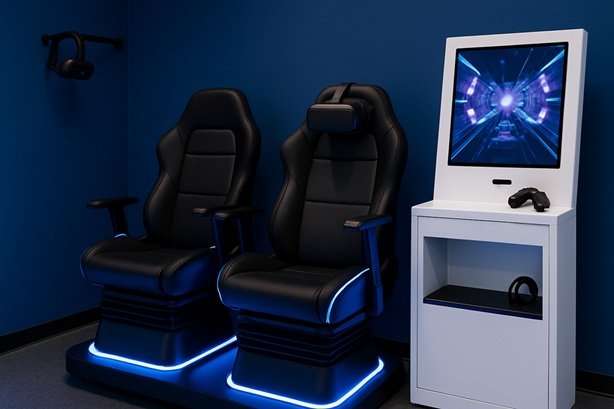Virtual reality has quickly moved from novelty to necessity in the world of location-based entertainment. With growing consumer interest and declining hardware costs, launching a VR entertainment center is now a realistic—and potentially highly profitable—venture. But success doesn’t come from flashy equipment alone. It requires careful planning, smart investment, and a strong understanding of the market.
In fact, according to a 2024 report by Grand View Research, the global VR gaming market is projected to reach USD 92.31 billion by 2030, growing at a CAGR of 30.2% from 2023. Forward-thinking entrepreneurs are seizing the opportunity, and many begin their research with a trusted vr roller coaster simulator manufacturer to explore high-return attractions.
Know Your Market First
Before you invest in expensive hardware or lease commercial space, research your local audience. Are you targeting teens, families, or corporate groups? Urban centers may lean toward social VR gaming experiences, while tourist areas might benefit from thrill-based attractions like VR roller coasters and motion simulators.
Key things to evaluate:
- Demographics: Age groups, income levels, and lifestyle.
- Competition: Are there other VR centers nearby? What do they offer?
- Foot traffic: Is your location near malls, cinemas, or entertainment hubs?
This groundwork helps you tailor your experience and pricing model to actual demand—not just assumptions.
The Essentials of a VR Center Setup
A profitable VR entertainment center typically includes a mix of experiences to attract diverse audiences. This might include:
- VR roller coaster simulators for immersive thrill rides
- Free-roam multiplayer arenas for group gaming
- Racing and flight simulators with motion platforms
- Escape room-style puzzles with interactive elements
- VR arcade booths for solo or casual gameplay
Each setup has different space, staffing, and maintenance requirements, so planning is key. Simulators with motion components often deliver higher engagement but may require more floor space and technical oversight.
Investment Breakdown (Estimated for Mid-Size Center)
| Category | Estimated Cost (USD) |
| VR equipment & simulators | $100,000 – $250,000 |
| Space rental (1 year) | $50,000 – $120,000 |
| Interior design & buildout | $30,000 – $70,000 |
| Staff training & salaries | $40,000 – $80,000 |
| Marketing & launch | $10,000 – $25,000 |
| Total Startup Cost | $230,000 – $545,000 |
Depending on your region, partnerships with local VR hardware providers can help bring down initial costs. Some manufacturers also offer lease-to-own or bundled content licensing options.
Revenue Streams Beyond Tickets
To stay profitable year-round, successful VR centers diversify income:
- Hourly or per-game ticketing
- Birthday parties and group bookings
- Corporate team-building events
- VR merchandise or branded accessories
- Monthly memberships or VIP passes
- Food and beverage add-ons
Upselling ride photos or digital souvenirs can add a steady trickle of passive income. Partnering with local schools or tourism offices can also generate consistent bookings.
Focus on Content Rotation
Content is king in the VR world. Even the most thrilling ride can grow stale if users have “seen it all.” Choose systems with regularly updated content libraries, or work with providers who offer seasonal or episodic experiences.
For example, a space-themed coaster can be transformed into a Halloween horror ride or a holiday adventure, keeping regulars coming back without major upgrades.
Operational Best Practices
- Sanitize equipment between uses: Cleanliness builds trust, especially with shared headsets.
- Train staff well: A poor onboarding experience or technical error can ruin a customer’s impression.
- Manage motion sickness risk: Offer guidance for first-timers and avoid over-intense simulations for sensitive riders.
- Track usage data: See which rides perform best and when traffic spikes to refine your operations and marketing.
Marketing That Brings People In
No matter how advanced your equipment is, your center won’t succeed without strong local marketing. Consider:
- Grand opening events with influencers or press invites
- Google My Business and Yelp optimization
- Social media videos showing real customers enjoying rides
- Online booking with group discounts
- Email lists and retargeting ads for promotions
User-generated content is gold—encourage guests to share videos and tag your venue on social media.
Final Thoughts
Launching a VR entertainment center is about more than technology. It’s about engineering a fun, repeatable experience that caters to your audience and operates efficiently. The tech is only as good as the business model behind it. With smart planning, content variety, and operational discipline, the return on investment can be substantial.
As the VR sector continues to scale, operators who partner with reliable equipment providers and deliver high-quality guest experiences will be in the best position to thrive. Whether you’re sourcing from a VR roller coaster simulator manufacturer or building a custom arena, the opportunity to lead the future of entertainment is right in front of you.


